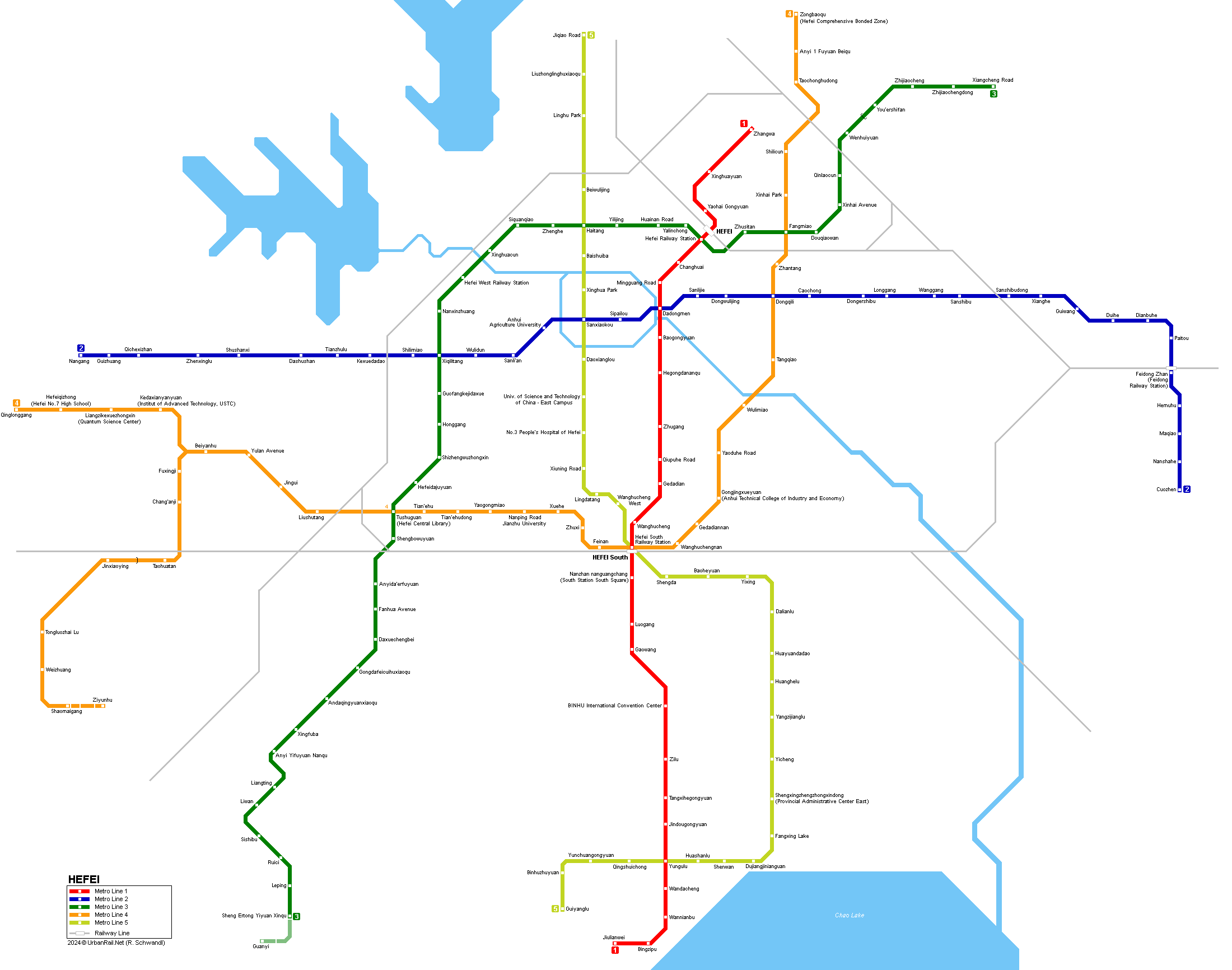
|
[ UrbanRail.Net ] [ Europe ] [ Americas ] [ Asia ] [ Africa ] [ Oceania ] [ News ] [ Books ] [ Links ] |
|
HEFEI
|
| China |

|
METRO
|
|
Hefei, a city in Anhui Province, 150 km west of Nanjing and 400 km west of Shanghai; with some 3.5 million inhabitants in the urban area. - 8-line
metro network planned, first line opened in Dec 2016: |
|
Line
1
|
|
29.1 km with 26 stations
26 Dec 2016: Hefei Railway Station - Jiulianwei (24.6 km) |
|
|
|
Line
2
|
|
42.3 km with 35 stations
26 Dec 2017: Nangang - Sanshibu (27.8 km)
|
|
|
|
Line
3
|
|
46.7 km with 40 stations
26 Dec 2019: Xiangcheng Road - Xingfuba (37.2 km) |
|
|
|
Line
4
|
|
41.4 km with 30 stations + 13.4 km branch with 8 stations
26 Dec 2021: Zongbaoqu – Qinglonggang (41.4 km)
|
|
|
|
Line
5
|
|
40.7 km north-south line with 33 stations
26 Dec 2020: Wanghucheng West - Guiyanglu (25.2 km)
|
|
|
|
Line
6
|
|
26
Dec 2021: Qinglonggang – Beiyanhu (opened as part of line
4) 26 Dec 2025: (Qinglonggang –) Beiyanhu – Longtang (full length - 34.4 km)
|
|
Line
8
|
|
26 Dec 2024: Yilijing – Beicheng Gaotiezhan (22.5 km)
|
|
Photos
|
|
Links
|
|
Hefei Metro (Hefei Urban Rail Transit Co. Ltd. - Official Website) Hefei Metro at Wikipedia
|
|
In March 2018, Craig Moore reports from Hefei: Hefei is planning a medium-sized Metro network of five lines, of which two currently operate as fully underground provision in the classic ‘+’ formation, covering 50.5km (revenue Km) and hosting 46 stations. Line 1 runs from the newly developed high technology hub in the far south, via the city’s high speed train station (Hefei South Station) and then along the main north-south artery to Dadongmen, the transfer station to Line 2 and the busiest station on the network. Heading north of the centre, the line finally reaches North Railway station. The 23.3km line takes 46mins to traverse. At street level the stations have a standard entrance structure with a basic totem and information boards. The edging of the angular structure is illuminated with narrow lighting strips which, at night, looks impressive. The entrance halls are rectangular with pillars along the entire length, nice red ticket machines, dispensing 2-7 yuan tickets dependent on distance to be travelled. Security, access barriers and information office are down one side of the space. At either end of the entrance hall (and platform) is a schematic map which shows the two lines and all planned lines (in faded grey). Moving down to the platform level, these are quite standard with island platforms housing full platform screens with strip map, LCD screens with next-train information, seating and the schematic at the end of platforms. The pillars, stairwells and central lift shaft give quite a cluttered feel. The pillars and white panelling have a red trim with traditional Chinese motifs and bold station names in large calligraphic letters and this adds affect to, what would otherwise be, quite a featureless space. Stations are pretty similar with the exception of South Station and Hefei Station. South Station has a huge entrance level and side platforms and panelling to block the view across to the opposite platform, whilst Hefei Station has an island platform, bordered by two side platforms to allow exit from both sides of the train at peak times. Dadongmen station is deep because of the water table as it is located next to the river which formed the defence of the ancient old town (of which there is now no trace except street patterns) and so platform to exit requires three long escalator rides. Dadongmen also provides access to Line 2 which runs from Shanshibu in the east, under the main road through the city centre (Shouchun Road) and out to the far western suburbs around Guizhuang. Given the basic ‘+’ formation of the system, transfer between lines involves walking along an angled corridor above either line platform and descending again to the alternate line (Line 1 is the deeper line). Once away from Dadongmen, Line 2 shows it is newer and has more sparkle, with entrance halls and platforms having distinctive features. Although the basic outline structures remain the same as Line 1, in the west the stations have colourful, themed pillars and 3 dimensional ceilings (of particular interest are Sanxiaoku, Sipalou and Dashushan), whilst in the east, the line has small coloured tiling/brick style on stair walls, and interesting station name boards. The Line is 27.2km and takes 49mins. The CSR Nanjing stock operates 6-car sets at 6/7min base headways and the trains have a white, black and red/blue exterior colour scheme and the frontage is quite streamlined. The interior is predominantly white with white side seating and red or blue end plates dependent on the line. The above-door strip map is dynamic with three changing styles, from full line strip (Chinese only), current station and ‘previous-next’ stations. Audio is in Mandarin and English.
|
|
|
|
|
2016 © Robert Schwandl (UrbanRail.Net)